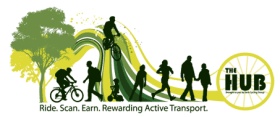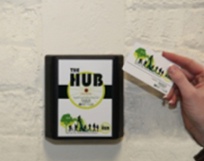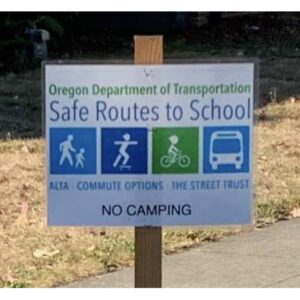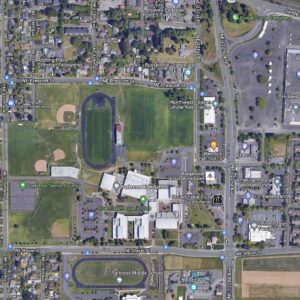
The Portland Bureau of Transportation (PBOT) is going high-tech with their vaunted Safe Routes to School program. In an effort to motivate kids to bike and walk to school, they’ve purchased a product that uses radio frequency identification (RFID) technology to automatically track school travel trips.
PBOT has won a $35,000 grant from the Oregon Department of Transportation that they intend to use for bike parking and for the purchase of a The Hub, a software package from Saris Cycling Group*. Gabe Graff, who manages PBOT’s Safe Routes program, says they plan to implement The Hub at four of the 80 schools that receive the program.
“We’re interested in giving schools, parents, and volunteers a really easy way to incentivize biking or walking to school,” says Graff.

(Photo: Saris)
The Saris Hub system records the number of trips students take and keeps track of their total miles traveled. The idea is to use the data to create friendly competitions and challenges among students and schools. The ongoing rankings can be tracked online and kids compete to see who can log the most trips. Once the system is in place, school staff can award prizes to top finishers all with an eye toward encouraging more walking and biking.
The system works via a card carried by each student (it can be attached to a helmet) that’s scanned into the system as they park their bike or walk into school. All the data is compiled on a Saris-hosted website, which removes the burden of keeping track of trips away from teachers and school administrators.
Graff says PBOT hopes to launch the program this month after a meeting and training session with interested schools. If you’re interested in getting one these systems at your school email saferoutes@portlandoregon.gov for more information on how to get involved.
Learn more about The Hub on the Saris website or download a presentation about it here (PDF).
Below is a video from Saris that shares more about the program:
*Total cost to implement The Hub at these four schools is $8,400. The rest of the grant money will go toward bike parking.





Thanks for reading.
BikePortland has served this community with independent community journalism since 2005. We rely on subscriptions from readers like you to survive. Your financial support is vital in keeping this valuable resource alive and well.
Please subscribe today to strengthen and expand our work.
How does the card know how far the bike was ridden? As best I can tell from that video and the Saris website, the card just seems like an electronic means of tallying who rode and who didn’t on a given day. Presumably the riders have to create an account and specify how far they are riding. If I’m right, this seems like a very expensive bit of technology for what it does.
I’m all for tricks to motivate more folks to do this, but I’ll concur with CPAC that the price seems, well, very high. But then I also have trouble understanding how a pair of flashing lights at a crosswalk can cost $24,000.
$35K is nothing. Every time a price tag is listed for absolutely anything on this site, there’s always someone(s) complaining that it’s too high. Everyone wants change but gee, it’s so expensive.
How much do you think it should cost? RFID hardware. RFID cards. User account management. Group management. Useable by children. Online help. Branding. Statistics display. Flexible rewards system. Messaging. Brochures. Hosting. Testing. User support. And that’s just off the top of my head.
$35K sounds like a bargain to me.
Thanks for clarifying. I appreciate the details you filled in. To me calling it a software package made it sound less full service than what you’re describing.
I’m very likely one of those who frequently complains about what stuff apparently costs so I accept your criticism.
I’ll say that part of my concern about costs comes not from miserliness but from my own personal desire to get away from monetizing everything in our daily lives, doing more of this sort of thing ourselves, but I recognize that is not the direction we seem to be moving in.
http://marksundeen.com/the-man-who-quit-money/
Perhaps it is a bargain.
But the cards and reader strike me as just a more expensive way of somebody putting a checkbox next to their name on a posterboard each time they bike in. Add in a person with a spreadsheet and the ability to upload to a website and you’ve got the functional equivalent for what I’m guessing is a lot less.
All that said, there are any number of reasons this could turn out to be worth it: this is just a test run for a system that they want to deploy at all 80 schools (I’m sure Saris scales better than posterboard). It provides realtime feadback, and it doesn’t require them to hire somebody to do a couple hours of spreadsheet calculations each month. It could be a great investment.
But if all Saris is is gadget for tracking bike rides at a couple schools where posterboard would suffice, I would think Safe Routes could find other priorities.
We should also no rule out the possibility that the (parent) who throws together the spreadsheet in all likelihood then becomes or already is a local champion of this effort. We’re all busy, but sometimes, in some circumstances, getting your hands dirty is one of the best ways of institutionalizing something that is, at heart, a social activity.
The user creates an account, including specifying his or her one way commute length. With the card, the user simply scans the card to tally each commute. The user can also log in to the program and request to change their mileage if their commute alters from their typical route (say you biked from a friends house instead of from home). I hope this helps.
Do you know which schools get to participate?
very cool! Euegen has a similiar system which costs a lot more than this one. It will be exciting to see how this system plays out in Portland. I would love to see a counter on bikeportland listing how many riders rode to school each day from the various schools!
To clarify, a portion of the $35,000 grant ($8,400) will pay for these 4 trip tracking systems. The bulk of the funding will be used to provide quality bike parking at public schools currently lacking it.
Whaddyaknow! That sounds more like it.
PS – If you’re interested helping get one of these systems running at your school, shoot an email to saferoutes@portlandoregon.gov for more information on how to get involved.
Yes, we have been using an RFID system called Boltage (previously Freiker) since 2009 at the 4j School District in Eugene. After trying it out at one school we’ve expanded it to two other sets of two schools (4 schools total). Most of the funding has come from a research grant that is taking the information from the RFID reader and our parent/student surveys and tallies and looking at what kind of incentives as well as environmental changes might be at work to get more kids walking and biking at various schools.
I saw this Saris system at a conference this past fall and I’m excited to see how it works for Portland. We have had some complications with the solar power keeping our RFID readers charged but that has improved over the past couple of years. Plus Boltage is more expensive than this Saris system.
I do think these type of encouragement programs do work to get kids excited about walking and biking. It gets them to try it and then hooks them into the behavior. The studies are still out though….will keep you posted.
http://www.eugenesrts.org/news/boltage-encouragement-program-grows/